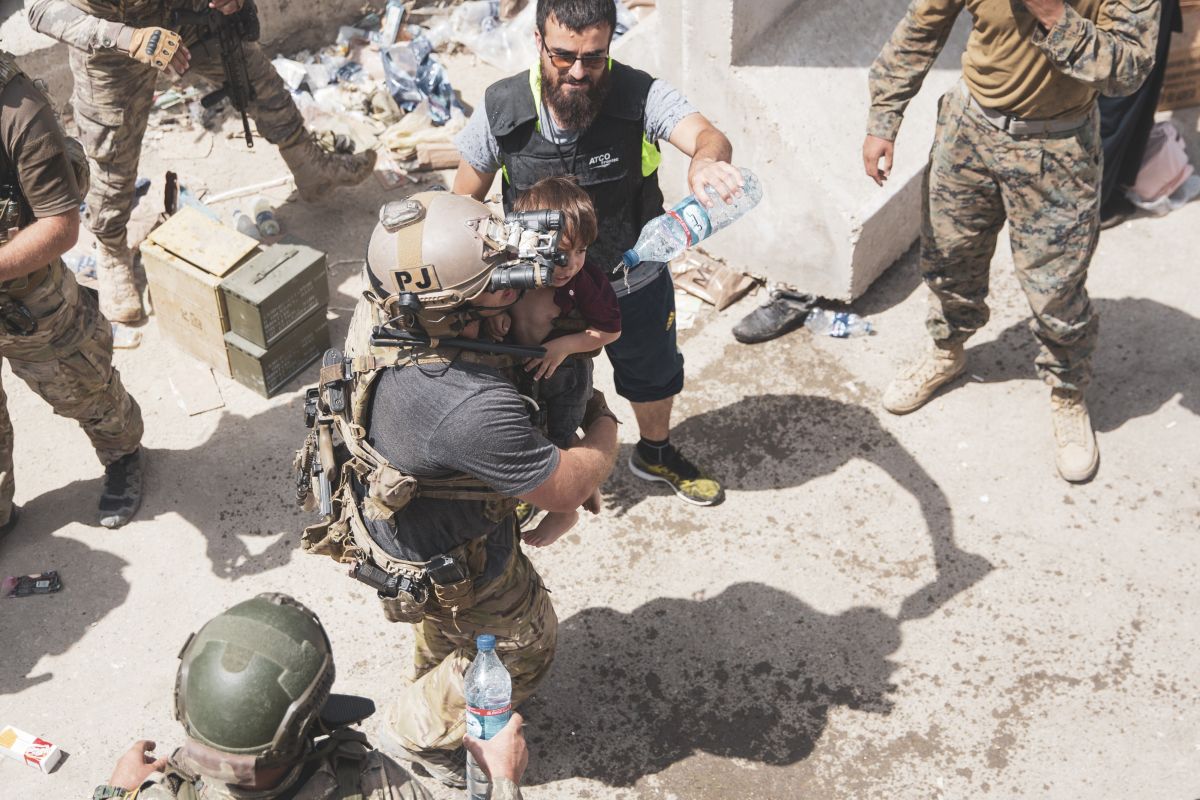EU Humanitarian Aid in Afghanistan: Needs and Challenges
The Taliban offensive in Afghanistan has deepened the humanitarian crisis in the country. Afghans are struggling now with forced displacement as well as a food and health crisis. The EU will increase its humanitarian aid, but its effectiveness will be limited by dangerous working conditions for NGOs. This requires an agreement with the Taliban to respect humanitarian law.
 Photo: Ssgt. Victor Mancilla/U.S. Marin/Zuma Press
Photo: Ssgt. Victor Mancilla/U.S. Marin/Zuma Press
The aim of humanitarian aid is to save and protect people’s lives regardless of the political situation, which distinguishes it from development aid. Humanitarian aid consists of providing shelter, medical care, food, access to clean water, education, and essential services. The European Union already has experience working with the Taliban in this field outside of Afghanistan in 1996-2001, and later in territories occupied by them. Today, the EU is the second-largest humanitarian aid donor in this country after the U.S., providing a tenth of all aid (around $70 million, see table at end).
After the Taliban took power this month, the EU, similar to other major donors such as the U.S., the UK, and UN agencies, has continued delivery of humanitarian assistance in Afghanistan through partner organisations. The largest of them include the Norwegian Refugee Council, Doctors Without Borders, Emergency (Italy), UNHCR, and the International Committee of the Red Cross, all of which continue to operate on the spot. The EU plans to increase humanitarian aid up to €200 million in 2021, although, it, like some Member States, including Germany, Finland, and Sweden, has suspended development cooperation with Afghanistan, making it conditional on respect of human rights.
Humanitarian Needs in Afghanistan
According to UN estimates, 18.4 million Afghans—almost half of the country’s population—require humanitarian aid. This is due to the country’s low level of economic development and the weakness of state structures; according to World Bank data, 75% of public expenditure has been financed by foreign grants. The difficult situation was aggravated by the security crisis related to the Taliban offensive, as well as the effects of natural disasters, such as a flood in the west of the country and the worst drought in years.
Since the beginning of the year, 550,000 people have been forced to leave their homes, increasing the number of displaced persons to 4.2 million. Women and children are particularly at risk, amounting to 80% of the 250,000 people who have fled from the Taliban since May. The conditions in the camps for displaced persons are poor, as they lack access to water and sanitary facilities. The number of refugees is currently difficult to estimate, both because of the dynamic situation at the Kabul airport and at the land border crossings controlled by the Taliban, who hinder the movement of people. Neighbouring countries are also trying to prevent migration, for example, Pakistan and Iran are sealing the borders.
The food crisis is currently affecting 12.2 million Afghans. It is deepened by the decline in agricultural production by 28% compared to last year and rising food prices. Half of children under five and 25% of pregnant women suffer from severe malnutrition. Many people are not receiving wages or have lost their jobs, and more than 50% of the country’s population now live below the poverty line (the World Bank estimates that it could soon be as much as 70%).
Afghanistan is also suffering from a health crisis. One-third of the country’s population does not have access to basic health care. The risk of an increase in COVID-19 cases is high due to the low percentage of vaccinated people (just over 1% of the population). Access to testing is very limited and the actual scale of the epidemic is difficult to estimate.
Challenges for the EU
The humanitarian aid volume of the EU and other donors does not meet Afghanistan’s growing needs. The UN estimates that around $1.3 billion worth is required, but only 39% of that amount has been collected so far. While major donors are increasing contributions, some countries are likely to temporarily cut off funding for organisational reasons. They will also be reluctant to divert funds to the activities of unknown Afghan organisations that may be controlled by the Taliban.
The EU will have to adapt the delivery of humanitarian aid to the new situation. In particular, it has to organise the operation of the EU delegation and the office for humanitarian aid (ECHO), evacuated from Kabul. Although humanitarian operations can be coordinated from Brussels, swift re-location of those structures in a country neighbouring Afghanistan would enable regular political contacts with the authorities there as well as working contacts with local staff. The implementation of projects will be limited by the shrinking number of humanitarian workers on the ground. According to the UN, in 2020 there were 161 NGOs operating in this field in Afghanistan (half of them were Afghan organisations). Some of their employees, especially foreign ones, are leaving the country due to the risk of retaliation by the Taliban. Remote management will hamper the flow of information, monitoring of project implementation, and assessment of the needs of local communities. It will also limit the coordination of all international aid as European Commission expert missions had been providing many countries with valuable knowledge about the humanitarian situation in individual regions.
The biggest challenge will be the dangerous working conditions for NGOs. Afghanistan has for years topped the list of countries with the highest number of attacks on humanitarian workers (on average a dozen cases per year). There are also reports that the Taliban are actively looking for people associated with coalition forces, threatening entire families with death if they do not surrender voluntarily (this despite declaring full amnesty). The possibilities of aid delivery will depend on an agreement with the Taliban to respect humanitarian law by them. The head of EU diplomacy, Josep Borrell, coordinates the EU’s actions in this field with the G7 group, which includes important donors of international aid in Afghanistan. Even if an agreement is reached, it is doubtful that it will guarantee fully safe working conditions. So far, the implementation of humanitarian aid has depended on the attitude of the local Taliban leadership and the negotiations conducted with them by Afghan humanitarian workers. Depending on the region, there are examples of positive cooperation but also limitations in the activities of NGOs or attacks on their activists.
A problem for the EU will remain how to ensure equal access to aid for the most vulnerable groups and transparency in spending. The local Taliban leadership determines who can help and benefit from aid (women are often forbidden to do so), and where resources will be directed (some of which go directly to the Taliban). Although the Taliban theoretically have been allowing women to be educated at the basic level under certain conditions, in practice, in territories under their control no such schools for women have been created due to fear of the consequences. The declared introduction of Sharia law throughout the country may even deepen these trends.
In light of development cooperation suspension, a challenge will be to improve the situation of Afghan society in the long term. Humanitarian aid is a short-term solution. EU aid in the form of cash transfers to people affected by the crisis is provided for only several months, while displaced persons typically remain in camps for many years. The EU is the largest health donor in Afghanistan, for example, by sending mobile medical points to rural areas and subsidising hospital activities. If there is no funding to develop local capacity in this area, humanitarian organisations will remain burdened with running medical facilities indefinitely.
Conclusions and Perspectives
Due to Afghanistan’s difficult internal situation and the cutting off of the Taliban from international financing (e.g., the assets of the Afghan central bank and access to reserves from the International Monetary Fund have been frozen), humanitarian needs in Afghanistan will increase in the near future. A boost in EU humanitarian aid is important, as it has a well-developed network of contacts and many years of experience in working in territories occupied by the Taliban. Depending on how the domestic situation develops, the EU may complement its support by resuming some development aid, but only if the Taliban ensure that women, children, and minorities have access to it.
Because of the difficult security conditions, a major challenge will be to provide on-site assistance. In practice, the implementation of projects will most likely continue to depend on the decisions of the local Taliban leadership and will pose a risk primarily to Afghan staff of international organisations. The European Commission should therefore, in cooperation with the G7, insist on the implementation of humanitarian law by the Taliban and monitor their actions.
Largest Aid Donors/Funds in the Scope of UN-Coordinated Aid in 2021
(the “Humanitarian Response Plan”).
|
Donor/Fund |
Aid (in USD) |
Percentage of aid |
|
United States of America |
223.48 |
44.96% |
|
European Commission |
69.61 |
14.00% |
|
Central Emergency Response Fund (CERF) |
30.00 |
6.03% |
|
Japan |
26.93 |
5.42% |
|
Germany |
25.49 |
5.11% |
|
Denmark |
21.40 |
4.30% |
|
Sweden |
21.04 |
4.23% |
|
United Kingdom |
20.64 |
4.15% |
|
Canada |
18.10 |
3.64% |
|
Australia |
7.66 |
1.54% |
|
Norway |
5.32 |
1.07% |
|
Switzerland |
4.62 |
0.93% |
Source: PISM, own compilation.
In the scope of the “Humanitarian Response Plan”, 78.4% of all humanitarian aid in Afghanistan is coordinated (many countries provide it independently); the EU’s share in total aid is thus around 11%.



